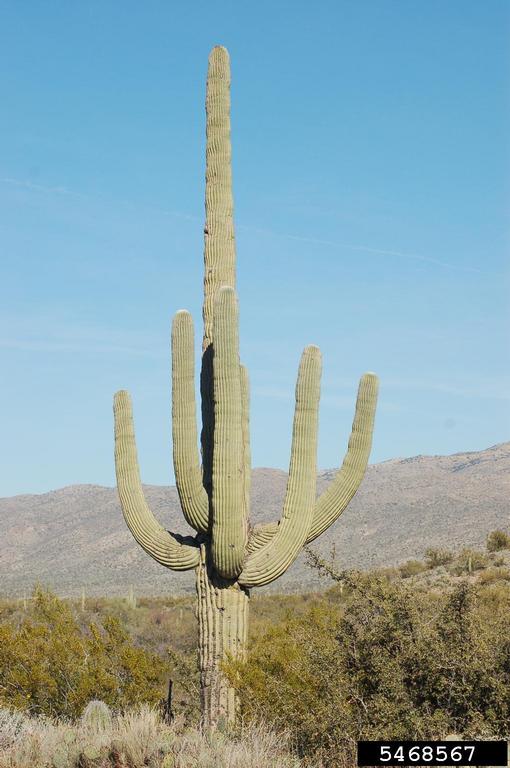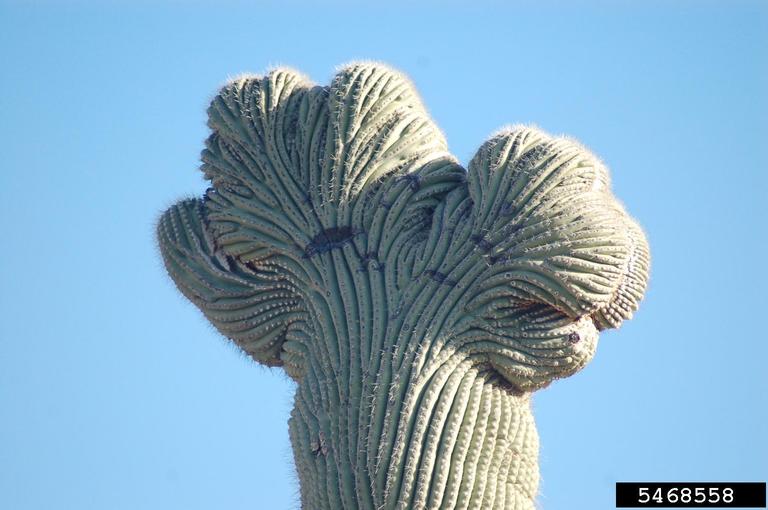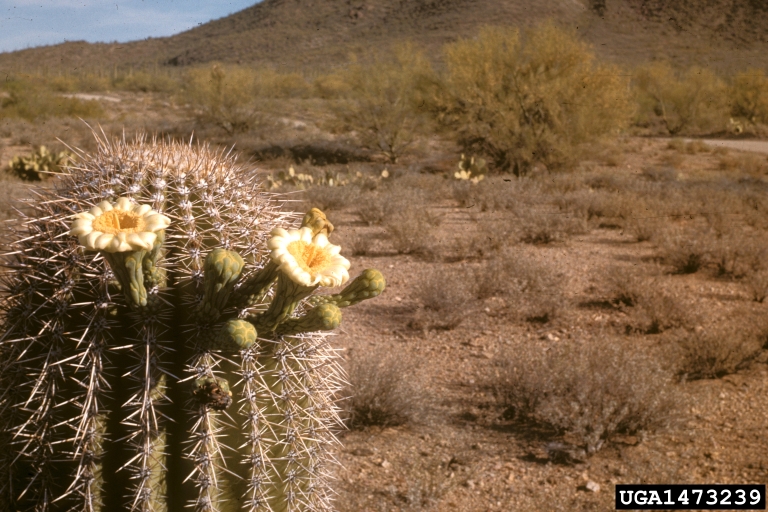 Saguaro Cactus - August 16, 2017 Jeff Schalau, Agent, Agriculture & Natural Resources University of Arizona Cooperative Extension, Yavapai County The saguaro cactus (Carnegiea gigantea) is an Arizona icon and our official state flower. Saguaro cacti are not native to the Verde Valley but I’ve seen a few of them growing in private landscapes in Cottonwood, Arizona. These specimens are grown in protected areas where a warmer microclimate has been created. These microclimates may include masonry walls or structures having thermal mass that will reradiate heat when freezing temperatures are present. I wouldn’t be surprised if the owners of the Saguaros also use blankets or heaters to get them through the coldest nights. I’m not recommending them, but there are certain gardeners that look for a “challenge”. They may be the same gardeners that try to grow blueberries, hostas, and hydrangeas in Arizona. Saguaros are the largest cactus species in the U.S. and can grow more than 40 feet tall yet they are very slow growing. In the northern portion of their range saguaros are most plentiful on the warmer south facing slopes. By 95-100 years in age, a saguaro cactus can reach a height of 15-16 feet, and could start to produce its first arm. By 200 years, the saguaro cactus has reached its full height, reaching upwards of 45 feet tall. It is difficult to age saguaros because they are not true woody plants with growth rings. Saguaros are pollinated by bats, birds, and insects. In their native range, young saguaros are often found under mesquite, ironwood, or palo verde trees. They grow there because a cactus wren has eaten the fruit, landed on a branch, and passed the seed in their droppings. This is fortunate for the saguaro because the tree acts as a “nurse plant” providing protection to the developing cactus. Saguaros don’t always grow in the iconic form we recognize in cartoons and movies. Some exhibit a “crested” growth form having a fan-like structure referred to as a cristate. You often see crested specimens at arboreta, but it is rare to encounter one in the desert. Biologists disagree as to the cause of the crested growth form. It could be from a mutation or possibly a lightning strike. Either way, look around for crested saguaros when you are out exploring the Sonoran Desert. Saguaros also provide habitat to many bird species which include the gilded flicker and Gila woodpecker. Once these two species excavate a nest cavity, elf owls, screech owls, purple martins, and finches will subsequently occupy the established nesting cavities. Harris hawks and red-tailed hawks build nests out of sticks in the saguaro’s arms. After these species abandon those nests, ravens and great horned owls may also move in. Cactus rustling was once a common problem in Arizona. Here, plant thieves, clandestinely excavate saguaros, load them into trucks, and transport them away from their native habitat to be sold into landscape slavery. Maybe this is a little dramatic, but Arizona’s Native Plant Laws were developed in response to widespread cactus rustling. Today, many species, including the saguaro cactus, are protected by native plant laws. Skilled professionals may also bid for salvage contracts when saguaros are in the path of development. Another threat to saguaros is a disease called bacterial necrosis. Here, the bacterial pathogen enters the cactus through a wound and infects the tissue. Dark, soft circles appear and enlarge, splitting open and leaking a dark, odorous material. Other infected areas may become dry, crack open, and reveal the remains of dry diseased tissue. Yet another threat to saguaro is fire. Invasive grasses have been introduced to Arizona deserts which are very tolerant of fire. Saguaro cacti did not evolve in a fire adapted ecosystem and have no adaptations which allow them to withstand fire and the associated heat. Buffelgrass (Cenchrus ciliaris) is a warm season perennial and cool season annual grasses such and red brome and Japanese brome are highly adapted to fire. These grass species carry fire into the desert and if saguaros are heated to a certain degree, they cannot recover from the heat damage. Saguaros have lots of other interesting facets including providing native peoples with food, swelling and shrinking as moisture comes and goes with the seasons, and unique inner structures called ribs that support their amazing mass. See below for photos of flowers, fruit, a crested specimen and more. Follow the Backyard Gardener on Twitter – use the link on the BYG website. If you have other gardening questions, call the Master Gardener help line in the Camp Verde office at 928-554-8992 or e-mail us at verdevalleymg@gmail.com and be sure to include your name, address and phone number. Find past Backyard Gardener columns or provide feedback at the Backyard Gardener web site: http://cals.arizona.edu/yavapai/anr/hort/byg/. Photos  Saguaro cactus (Carnegiea gigantea, Joy Viola, Northeastern University, Bugwood.org).
Saguaro cactus (Carnegiea gigantea, Joy Viola, Northeastern University, Bugwood.org). Crested saguaro cactus (Joy Viola, Northeastern University, Bugwood.org).
Crested saguaro cactus (Joy Viola, Northeastern University, Bugwood.org). Saguaro cactus flowers (Rocky Mountain Research Station - Forest Pathology , USDA Forest Service, Bugwood.org).
Saguaro cactus flowers (Rocky Mountain Research Station - Forest Pathology , USDA Forest Service, Bugwood.org).Additional Resources Saguaro Cactus Arizona-Sonoran Desert Museum www.desertmuseum.org/kids/oz/long-fact-sheets/Saguaro%20Cactus.php Saguaro Fruit: A Traditional Harvest National Park Service www.nps.gov/sagu/learn/historyculture/upload/Saguaro-Fruit-A-Traditional-Harvest-Brief.pdf |